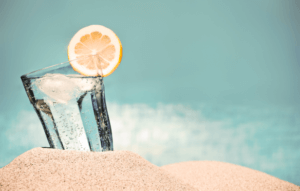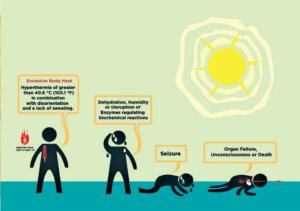Proper skin care during summer is crucial. Control of body temperature through sweat production is essential for life. The maintenance of our body temperature at 37°C is vital to many biochemical reactions. Normally, the body stays cool by letting heat escape through the skin and by evaporating sweat (perspiration), which helps cool the skin and the body core. But in hot, humid weather, sweat doesn’t work as well, says Consultant Dermatologist Dr. Parvathi Padmanabhan.
The surrounding air is already warm and heavy with humidity, and it cannot absorb extra heat and sweat. So the body begins to warm up, and the heart begins pumping more blood to the skin to release the extra heat. Humans have several million eccrine sweat glands distributed over nearly the entire body surface.
Doing too much on a hot day, spending too much time in the sun or staying too long in an overheated place can cause heat-related illnesses and a bunch of skin diseases. A little common sense will give the body’s thermostat a chance to recover.
Complications associated with too much or too little sweating can range from annoying to life-threatening.
What is Prickly Heat:
Prickly heat is a common disorder of the sweat glands. Sweat glands are coil-shaped and extend deep into the skin. They are capable of plugging up at several different depths, producing four distinct skin rashes.
- Miliaria crystallina is the most superficial of the occlusions. At this level, only the thin upper layer of skin is affected. Little blisters of sweat that cannot escape to the surface are formed.
- Deeper plugging causes miliaria rubra as the sweat seeps into the living layers of skin, where it irritates and itches.
- Miliaria pustulosais (a complication of miliaria rubra) occurs when the sweat is infected with pyogenic bacteria and turns to pus.
- Deeper still is miliaria profunda. The skin is dry, and goose bumps may or may not appear.
The rash disappears in a day with cooler temperatures, but the skin may not recover its ability to sweat for two weeks-the times needed to replace the top layers of skin with new growth from below.
The best treatment for heat rash is:
- To provide a cooler, less humid environment.
- Keep the affected area dry.
- Dusting powder may be used to increase comfort, but avoid using ointments or creams, they keep the skin warm and moist and may make the condition worse.
What is Intertrigo?
This is a yeast infection of skin folds caused by Candida albicans. In areas of the body that have skin touching skin such as the armpits, groin, and under heavy breasts or fat folds, the environment is warm and moist. Intertrigo is characterized by an intensely red, macerated, glistening rash with scaling on the edges.
Intertrigo is treated with antifungal creams. Equally important in the treatment of intertrigo is keeping the skin folds as dry as possible. Most preventative measures involve reducing skin to skin contact and keeping the area dry.
- Weight loss to reduce the size of fat folds
- Wear loose, soft underclothing
- Apply antifungal absorbent powder to affected areas daily
- Wash affected areas with soap and water daily
What is Sunburn?
Sunburn should be avoided because it damages the skin. The skin becomes red, painful, and abnormally warm after sun exposure. Consult a doctor if the sunburn affects an infant younger than 1 year of age or if these symptoms are present:
- Fever , fluid-filled blisters, severe pain
- Apply cold compresses or immerse the sunburned area in cool water.
- Apply moisturizing lotion to affected areas. Do not use salve, butter, or ointment.
- Do not break blisters.
Fungal nail infections:
People who sweat profusely are prone to many types of fungal infections. That’s because fungi thrive in warm, moist environments such as sweaty shoes. You may even detect a slight odour.
What is Athlete’s foot?
Sometimes sweaty feet just smell bad. The fungal infection usually begins between your toes and causes your skin to itch, burn and crack. Athlete’s foot can also affect the soles and sides of your feet, causing your skin to peel or thicken.
Jock itch
This fungal infection causes an itching or burning sensation around your groin. You may also have a red rash on your inner thighs and buttocks.
Bacterial infections
Excessive sweating can contribute to bacterial infections, especially between your toes and as heat boils elsewhere.
Body odour
There are people who have body odour and foul smell simply wafts with them as they walk along their merry way. A split second of hell, and then it’s over. Although perspiration is basically odourless, it can take on an unpleasant smell when it comes into contact with bacteria on your skin. , as t
- Go light on hot spices, onion and garlic, as these aggravate the body odour.
- Shower two or three times a day with an antiseptic soap. Use deodorants and talcum powder.
- The armpits and the pubic area are the main area of concern when it comes to body odour, the reason being that these areas are covered, and the sweat does not dry soon enough causing the bacteria to decompose it. So keep hair trimmed, wear loose, cotton undergarments and avoid wearing tight clothes in warm weather.
Also read: Planning a surgery in summer? You need to read this
General Tips to keep cool and avoid heat-related problems

Pic courtesy: tvakh india
Spend as much time as you can in cooler surroundings – a cooler room in your home, an air-conditioned shopping mall, senior center, public library or movie theater. Even a few hours a day in air conditioning is important.
Take cool baths and showers- cool water temperatures cool your body 25 times faster than cool air.
Wear lightweight, light colored and loose fitting clothes to keep you cool.
Also, wear a hat or use an umbrella to protect your head and neck when you have to be outdoors.
Drink liquids often and don’t wait till you are thirsty. Your body needs more fluid than thirst will indicate. By the time you feel thirsty, you may already be dangerously low on water. Water is the safest liquid to drink during extreme heat. Drink curd and coconut water to keep your system cool. Fruits like lemon, oranges and watermelon can be used for the same purpose.
Slow down, take it easy if you can and avoiding strenuous activities. Strenuous activities should be reduced, eliminated, or rescheduled to the coolest time of the day.
Avoid hot foods and heavy meals. They add heat to your body. Eat small meals and eat more often. Avoid foods that are high in protein, which increase metabolic heat.
Avoid drinks with alcohol or caffeine in them. They can make you feel good briefly, but make the heat’s effects on your body worse.
Sunburn affects your body’s ability to cool itself and causes a loss of body fluids. If you must go outdoors, protect yourself from the sun by wearing a wide-brimmed hat (also keeps you cooler) along with sunglasses, and by putting on sunscreen of SPF 15 or higher 30 minutes prior to going out. Continue to reapply it according to the package directions.
If you have a disease, a medical condition, or a problem with body water balance, check with your doctor for advice on how much water you should drink in hot weather. Don’t increase your salt intake or take salt tablets without your doctor’s permission.
At Home
Keep shades and drapes closed in the early morning to keep the cooler night air inside the house.
Use fans and they draw cool air into your home at night and help to provide good indoor air circulation during the day. Air movement reduces heat stress by helping to remove extra body heat. Fans do not cool the air, but they do help sweat evaporate, which cools your body.
Spend more time in air-conditioned places. If you cannot afford an air conditioner, spending some time each day (during hot weather) in an air-conditioned environment which affords some protection.
Common skin complications of excessive sweating include:
- Heat rash or prickly heat
- Intertrigo
- Fungal nail infections.
- Athlete’s foot.
- Jock itch.
- Bacterial infections.
- Body odour
When you stop sweating or don’t perspire enough to cool your body, the results can be serious or even fatal. Complications of a lack of perspiration include:
- Heat exhaustion.
- Heat cramps.
- Heat stroke

Pic courtesy: PCHRD
Heat Exhaustion
Heat exhaustion is a milder form of heat-related illness that can develop after several days of exposure to high temperatures and inadequate or unbalanced replacement of fluids. It is the body’s response to an excessive loss of the water and salt contained in sweat. Those most prone to heat exhaustion are elderly people, people with high blood pressure, and people working or exercising in a hot environment.
Warning signs:
- Heavy sweating
- Paleness
- Muscle cramps
- Tiredness
- Weakness
- Dizziness
- Headache
- Nausea or vomiting
- Fainting
Seek medical attention if symptoms worsen or last longer than 1 hour.
Cooling measures include:
- Rest
- Cool shower, bath, or sponge bath
- An air-conditioned environment
Heat Stroke
Heat stroke occurs when the body is unable to regulate its temperature. The body’s temperature rises rapidly, the sweating mechanism fails, and the body is unable to cool down. Heat stroke can cause death or permanent disability if emergency treatment is not provided.
Warning signs of heat stroke:
- An extremely high body temperature (above 103°F, orally)
- Red, hot, and dry skin (no sweating)
- Rapid, strong pulse
- Throbbing headache
- Dizziness
- Nausea
- Confusion
- Unconsciousness
Get medical assistance as soon as possible. Until then you can:
- Get the victim to a shady area.
- Cool the victim rapidly using whatever methods you can. For example, immerse the victim in a tub of cool water; place the person in a cool shower; spray the victim with cool water from a garden hose; sponge the person with cool water; or if the humidity is low, wrap the victim in a cool, wet sheet and fan him or her vigorously.
- Monitor body temperature, and continue cooling efforts until the body temperature drops to 101-102°F.
- Do not give the victim fluids to drink.
Heat Cramps
Heat cramps usually affect people who sweat a lot during strenuous activity. This sweating depletes the body’s salt and moisture. The low salt level in the muscles causes painful cramps. Heat cramps may also be a symptom of heat exhaustion.
Warning signals:
Muscle pains or spasms usually in the abdomen, arms, or legs—that may occur in association with strenuous activity.
What to do
- Stop all activity, and sit quietly in a cool place.
- Drink clear juice or a sports beverage.
- Do not return to strenuous activity for a few hours after the cramps subside, because further exertion may lead to heat exhaustion or heat stroke.
Seek medical attention for heat cramps if they do not subside in 1 hour.
